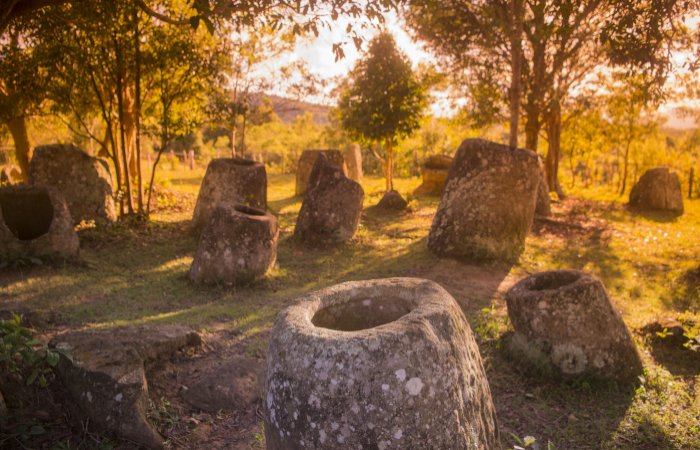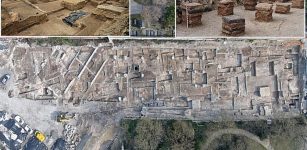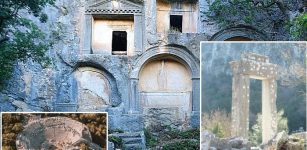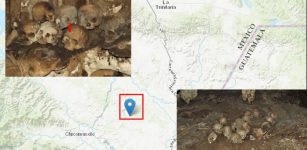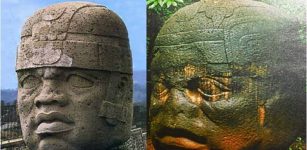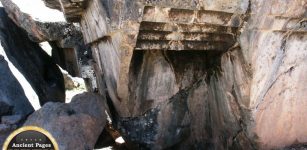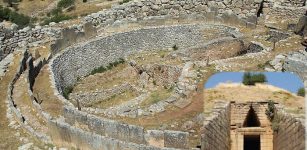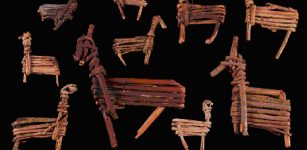Mysterious Ancient Giant Jars Made By An Unknown Civilization Discovered In India
Conny Waters - AncientPages.com - Scientists have discovered as many as 65 ancient jars made of sandstone in India. Some of these jars are giant and researchers suspect they were used for burial purposes. However, it is still unknown who made them. Could they somehow be connected to similar jars found in Laos?
Jars at Herakilo site. Credit: Tilok Thakuria
The enigmatic ancient jars have been unearthed across four new sites in Assam. According to the scientists from the Australian National University who participated in the archaeological project, the 65 newly discovered sandstone jars vary in shape and decoration, with some tall and cylindrical, and others partly or fully buried in the ground. Similar jars, some of which span up to three meters high and two meters wide, have previously been uncovered in Laos and Indonesia.
As reported previously by AncientPages, "the 1,000-year-old jars of Laos have long puzzled scientists. Experts believe they were related to the disposal of the dead, but nothing is known about the jars' original purpose and the people who brought them there.
In 2021, scientists used a technique called Optically Stimulated Luminescence (OSL) to determine when sediment grains were last exposed to sunlight researchers analyzed samples from the Laos jars. Studies suggested that Laos jars were of ritual importance to our ancestors. Later, the same year scientists investigated more jars and discovered some of these buried ceramic vessels contain the skeletal remains of infants and children.
Were The Ancient Jars In India And Laos Made By The Same Civilization?
"We still don't know who made the giant jars or where they lived. It's all a bit of a mystery," ANU Ph.D. student Nicholas Skopal said.
Another mystery is what the giant jars were used for. The researchers believe it is likely they were associated with mortuary practices.
Laos jars have long been an archaeological mystery. Credit: flu4022 - Adobe Stock
"There are stories from the Naga people, the current ethnic groups in north-east India, of finding the Assam jars filled with cremated remains, beads and other material artifacts," Skopal said. This theory aligns with findings from the other jar sites in countries including Laos, which are also tied to burial rituals.
Initially, the aim of the new research was to survey the existing sites in Assam. However, as the researchers moved about the landscape they realized there was more to be uncovered. "At the start the team just went in to survey three large sites that hadn't been formally surveyed. From there grids were set up to explore the surrounding densely forested regions," Skopal said.
"This is when we first started finding new jar sites. The team only searched a very limited area so there are likely to be a lot more out there, we just don't yet know where they are."
The surveying and reporting of these sites is of great importance in regards to heritage management in India.
"It seems as though there aren't any living ethnic groups in India associated with the jars, which means there is an importance to maintain the cultural heritage," Skopal said. "The longer we take to find them, the greater chance that they will be destroyed, as more crops are planted in these areas and the forests are cut down."
The researchers worked with local communities on the ground to uncover potential jar sites, often through areas of mountainous jungle that were difficult to navigate.
"Once the sites have been recorded, it becomes easier for the government to work with the local communities to protect and maintain them so they are not being destroyed," Skopal said.
See also: More Archaeology News
The research was led by Tilok Thakuria, from North-Eastern Hill University, and Uttam Bathari, from Gauhati University.
The study's findings are published in the Journal of Asian Archaeology.
Written by Conny Waters - AncientPages.com Staff Writer


